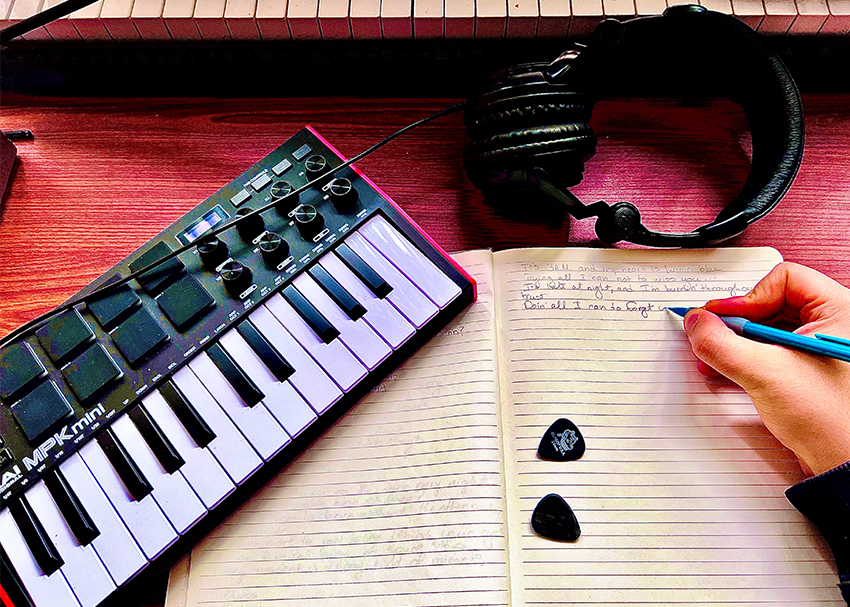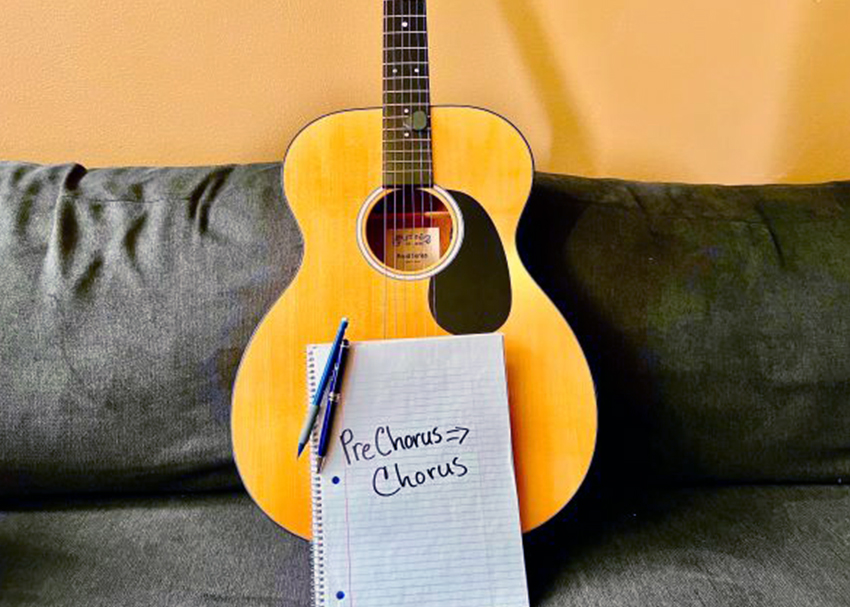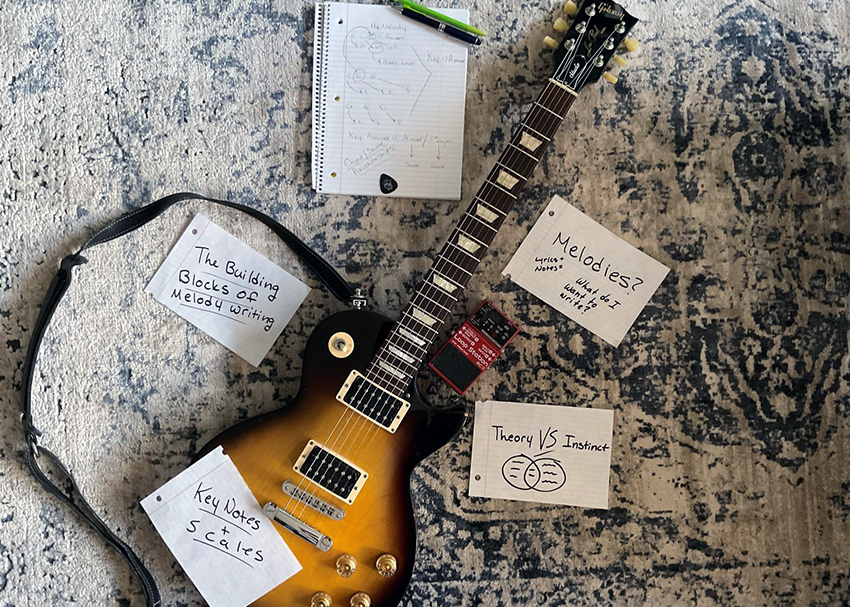Each part of a song has an important function. Whether it’s the chorus, the bridge, etc., each section serves a structural and artful purpose. However, the first verse has a unique job: setting the foundation of your song. In this post, we will discuss using a variety of lyrical devices to create an effective first verse to help lay the groundwork for a great song!
Now, before we get into the technical stuff, let’s address the elephant in the room. It’s a common thought that music theory can get in the way of writing something from the heart. The same applies to lyrics. Due to the amount of technicality that can be used in lyric writing, it could be argued that these techniques get in the way of true expression.
With that being said, this post will also help explain how to use these tools to inspire creativity from the heart and soul in your lyric writing. We will revisit this thought at the conclusion of the post.
Related: How to Transition From Pre-Chorus to Chorus
Songwriting “rules” should be viewed as options. Learn how to use anticipation and resolution to write and connect a pre-chorus to your chorus! | Read »
The Opening Verse Line
The opening line is a make-or-break moment in your song. It is the phrase or sentence that can determine whether or not the listener will keep listening. In this section, we’ll look at the use of questions, proclamations, color, time, and place as opening line devices.
Questions?
So, asking a question in your opening line can do one of two things. It might immediately make the listener look within, asking themselves the question. Or, it will prompt the listener to ask the question of you, the writer. It all depends on the question that is asked. For example:
What is love?
Introspective View: What is love? What does it mean to me? Do I even know what it is?
Outward View: Yes writer, I hear you. What is love? I should stick around to hear you tell me what it means to you, or what it means in general.
Another great example of an opening question: How many more times, treat me the way you wanna do? – Led Zeppelin.
To clarify, this isn’t to say that every question-based opening line needs to be written with the listener’s thoughts in mind. This is where the theory vs. heart and soul thought process comes in. You should write what you want to, based on how you feel. These devices should be used as nothing more than as a way to bring life to your song, keeping in mind that it could stir up some sort of thought in someone who may listen to it.
Place
These are great illustrative tools to begin your song with. It’s common to begin a story with a time and place to create a setting, or, time and place together. They work great in songs too.
Time – There are two different main ways to use time in your opening line. Starting with literal time, or, the time of day, this is a great way to get specific right away. Consider:
“It’s 3 a.m. and I’m thinkin’ of you” – Here, the generic line “I’m thinkin’ of you”, is bolstered by “It’s 3 a.m.”, adding a kind of weight and drama to it that makes it overall more interesting.
Or, you can also use a Time Frame :
“Yesterday, all my troubles seemed so far away” – “Yesterday” – The Beatles
Using a time frame broadens what is imagined while listening.
Place – Using “place” in your opening line can create a concrete or abstract setting for your song, depending on how you use it. Either way, it is another artful way for you to bring the listener somewhere right off of the bat.
Alternative “Place” Methods
Physical Place – This is a great tool to use to help convey something specific you are writing about. If you want to write about an experience you’ve had, using a place that is significant to that experience will help illustrate your story.
In France, a skinny man died of a big disease with a little name” – “Sign O’ The Times” – Prince
The song goes on to talk about hypocrisy and the inevitable facts of life and humans. However, the scene is set by the first line, where Prince illustrates and connects humankind around the world – connecting the themes of hypocrisy and the facts of human life.
Abstract Place – This is a great tool to use to dramatize your writing. These are not places you can physically go to, but we can certainly imagine them in our own minds.
“As I walk through the valley of the shadow of death / I take a look at my life and realize there’s not much left…” – “Gangsta’s Paradise” – Coolio
Time And Place
Combining time and place can be the ultimate stage setter for a song.
When I was a young boy / My father took me into the city…” – “Welcome to the Black Parade” – My Chemical Romance
This line highlights the broad time frame of childhood, while detailing a “place” in the use of a “city.” It sets up an opportunity for a story of nostalgia in a really creative way.
Proclamations!
Used correctly, starting a song with a proclamation can be a very strong attention grabber.
“Please allow me to introduce myself / I’m a man of wealth and taste” – “Sympathy for the Devil” – The Rolling Stones
“Dearly beloved, we have gathered here today / To get through this thing called life…” – “Let’s Go Crazy” – Prince
“I hurt myself today / To see if I still feel / I focus on the pain / The only thing that’s real...” – “Hurt” – Nine Inch Nails
These are bold, strong statements that grab your attention right from the start.
Related: A Guide to Basic Melody Writing
What is a melody, and how do we go about writing one? Explore that question, and learn a few compositional techniques in this post! | Read »
The Opening Verse
Now that we’ve gone over opening line devices, let’s dive into what makes a good overall first verse! There are various elements, including rhyme scheme and stanza structure.
So, starting with rhyme scheme, the pattern you choose can impact the momentum of the verse. This can be really fun to play and experiment with since the possibilities are endless! Generally in songwriting, rhyming patterns are notated with As, Bs, and Cs.
Verse Rhyming Patterns
For instance, "AAAA" form would have lines 1,2,3, and 4 all rhyming with each other. Example: Who says I can’t get stoned? Turn off the lights and the telephone. Me in my house alone Who says I can’t get stoned? "Who Says" - John Mayer
However, switching it up with ABAB, you will rhyme line 1 with line 3, and line 2 with line 4.
Example: I know what you’re thinkin‘ We were goin’ down I can feel the sinkin’ But then I came around “Wheels” – Foo Fighters
Let’s try another – AABB. Here, line 1 and 2 rhyme, while line 3 and 4 rhyme with each other.
Example : There’s a thirst inside of me I can’t control
There’s a desert underneath that cracks my bones
There’s a river that runs dry within my heart
There’s a distance to your light that seems too far
Love Rain Down – Myles Kennedy
AABBC- The Refrain Pattern
Now for something even a little more different, let’s take a look at AABBC. This pattern consists of a 5 line stanza, where the 5th line does not rhyme with any of the other lines. The 5th line is often a refrain – a repeated phrase occurring consistently throughout the song.
Example :
I’m ahead, I’m a man
I’m the first mammal to wear pants, (yeah)
I’m at peace with my lust
I can kill ’cause in god I trust, (yeah)
It’s evolution, baby!
Do The Evolution – Pearl Jam
Here, we see lines 1 and 3 rhyme and 2 and 4 rhyme, but the 5th line stands alone at the end of the verse. This is meant to put a nice stopping point to the stanza to give you a sense of finality, or a sense of the point being made. The refrain in a lot of cases turns out to either be the title of the song, or some variation of it.
So, taking a listen to the remaining verses in each song, you will find that they continue to follow the same rhyme pattern in each verse.
Verse/Stanza Structure
Rhyming plays a big part in stanza structure, but it is not the only aspect of it. When looking at stanza structure, we may also look at syllable use and overall length of the verse.
Generally speaking, in popular contemporary music, it works best to either have a consistent syllable count in each line, or to create a consistent pattern within a verse.
Let’s take Myles Kennedy’s “Love Rain Down” opening verse for example.
There’s a thirst inside of me I can’t control (11 syllables)
There’s a desert underneath that cracks my bones (11 syllables)
There’s a river that runs dry within my heart (11 syllables)
There’s a distance to your light that seems too far (11 syllables)
Each line has the same number of syllables, creating a nice, even, and stable momentum within this verse.
Shake Up The Patterns
For the purpose of practicing this idea, let’s mix that up a bit, and take a verse where the syllable count is the same in each line with the exception of one line in John Mayers’ “Who Says”
Example:
Who says I can’t get stoned? (6 syllables)
Turn off the lights and the telephone. (*9* syllables)
Me in my house alone (6 syllables)
Who says I can’t get stoned? (6 syllables)
This still feels very even, despite the second line having 3 more syllables than the 1st, 3rd, and 4th lines. So, why does this work? Lines 1,3, and 4 begin on the and of beat 1, while line 2 begins right on beat one, allowing more time to fit more syllables. This creates a nice change up in the middle of the verse without feeling like the flow of the verse has been interrupted.
Refrain Stanza Structure
Now, let’s switch it up to a flow that has a lot of syllable change up to it.
Example :
I’m ahead, I’m a man (6 syllables)
I’m the first mammal to wear pants, yeah (9 syllables)
I’m at peace with my lust (6 syllables)
I can kill ’cause in god I trust, yeah (9 syllables)
It’s evolution, baby (7 syllables)
To sum up this example from Pearl Jam’s “Do The Evolution,” we see that there’s a pattern in lines 1-4 with interchanging amounts of syllables. The exact number of syllables does not matter as much here, as long as there is a consistent pattern that works within the time signature of the song. However, when we get the 5th line, we see that there are 7 syllables, rather than 6 or 9. This works, because in this ABABC syllable scheme, that 5th line contrasts with purpose. It works within the time signature, and is consistent as a refrain through the rest of the song. It also works as the phrase begins on the upbeat of beat 3, allowing it to flow into, and finish evenly on beat 4 of the next bar.
So, what can we take from this? As stated earlier, how you use rhyme scheme and stanza structure in the first verse will lay the foundation for the rest of the verses in your song. Not only that, but in a lot of cases, in will also determine in contrast how you will form your choruses and bridge sections.
Let’s Write A Verse!
The Opening Line and Devices
To sum it up so far, we’ve really gone over a lot here. So, to tie it all together, let’s write our own opening verse! We won’t use a piece of every example shown in this post for this, but this original verse will serve as an example of how to pick and choose from the tactics we have gone over to create an effective and creative opening verse.
So, let’s start by using two of our opening line devices – Time and color.
“It’s 3 A.M. and my heart is burning blue”. (11 syllables)
Now, let’s write the rest of the verse building around the opening line, keeping syllable structure and stanza length in mind to create a pattern.
“Trying all I can, not to miss you” (9 syllables)
At this point, we have rhymed our first two lines. We can either rhyme the remaining two lines with the first two, or have lines 3 and 4 rhyme with each other. Either way we should aim to keep our syllable count consistent in pattern as we go.
“It’s Late at night, and I’m burning through our trust” (11 syllables)
“Doing all I can, to forget us” (9 syllables)
Now that we have made it through our first four lines, we have established an AABB rhyme pattern, with an interchanging pattern of syllables. Now, let’s end the verse with a refrain.
Burning the candle, with both ends (8 syllables)
This is a phrase that could be repeated in each 5 line verse, could be the title, and works as standalone syllable count at 8.
What To Take Away From This
In conclusion, there CAN be a lot that goes into writing an impactful first verse. The goal with songwriting is to convey some sort of message, and the start of message can play a big part in the artistic strength of your song. Starting with an attention-getting opening line device, playing with stanza and rhyme structure, it all matters. With enough practice, experimentation, and use of these concepts, you can enhance the quality of your songwriting to a professional level. With enough dedication to these ideas, writing with theory and writing from the heart, will be one in the same for you.






Leave a Reply